This is the story of Hannah Redman, the half sister of my great grandfather, Josiah Simeon Thomas Bullock. Until recently, her identity was unknown. She is recorded only once with her siblings, enumerated with them in the 1871 census as a 9 year old visitor. She was unknown because her illegitimate birth concealed her existence for many years. There must be many other individuals like Hannah who are missing from our family trees. They need to be found and acknowledged.
It was a Saturday morning, July 2nd 1864, and a little girl was very excited. Hannah had woken up early, as the noise of human activity on the street below mingled with the clip clop of horses and the whistle of trains arriving at Ealing station. Her mother looked out of the window of the attic bedroom of The North Star public house, where they had spent the night. Life was so different in the city. Kate and her little girl had boarded the train at Melksham yesterday afternoon, travelling on the Great Western Railway nearly all the way to London. They had got off at Ealing station, where Jimmy worked, and spent the night at the The North Star nearby, where Jimmy had been lodging since he got his new job as a porter at the station:
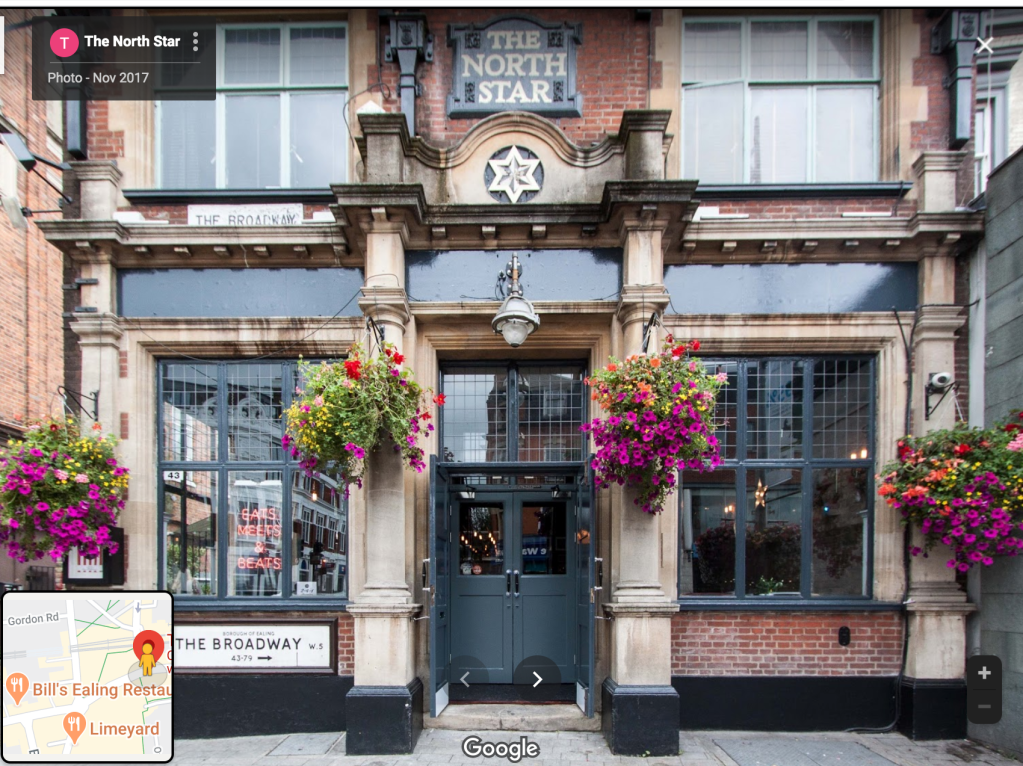
It was the start of a new adventure and a fresh start. Kate had to pinch herself, she couldn’t quite believe that this was the day she was getting married! It had been nice hearing her name, “Catherine Redman”, read out in church by the vicar these past three Sundays, linked together with her beloved, “James Bullock”. She had heard some of the old women in the village muttering under their breath that she was a “lucky girl”. She knew that this was true: some of the boys would not have wanted to marry her because she had Hannah. Jimmy was different though. He had promised to provide for them both, and far away from Atworth, no one need know about her history.
The sun was shining on this July morning and Kate, arm in arm with Jimmy and with Hannah holding her hand, set off for the short walk to the church where they were to give their vows and be declared man and wife. The marriage was taking place at Christ Church, Ealing, a relatively new church, consecrated in 1852 and designed by the well-known architect, Sir Gilbert Scott. No family were going to be present so it would be a quiet affair but Peter and Mary Theobald, the Wiltshire couple who ran The North Star, were coming along to be the witnesses. There would be a little celebration in the pub afterwards:

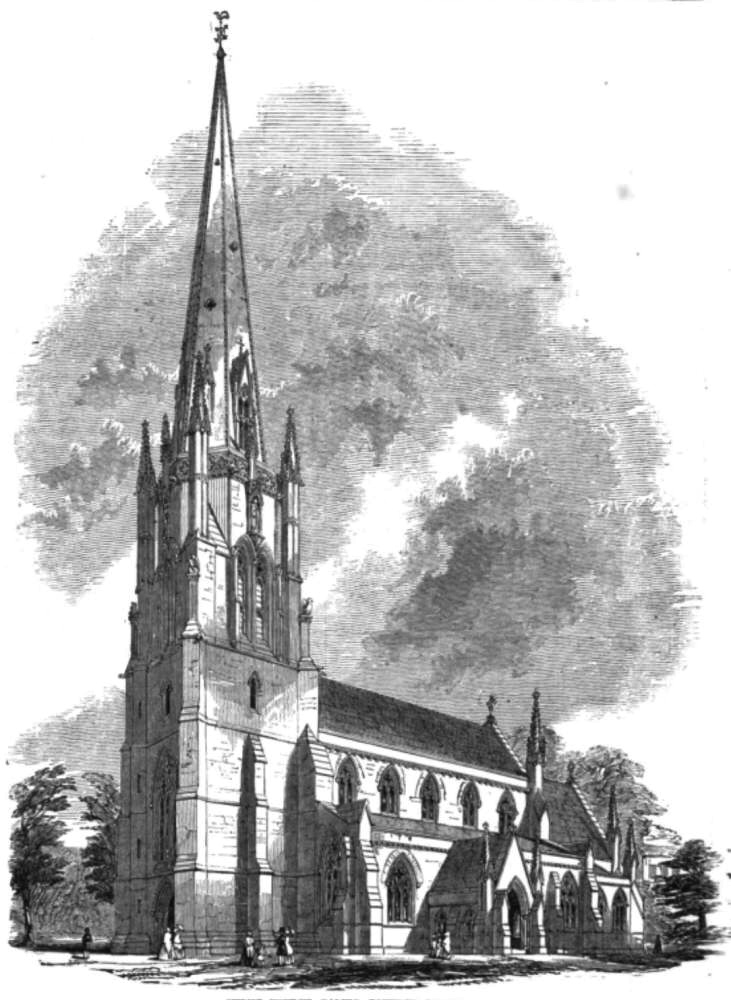
Catherine Redman, my two times great grandmother, was born in Atworth, a chapelry of Bradford upon Avon, Wiltshire in 1843, the daughter of an agricultural labourer, James Redman and his wife Hannah. By the time of the 1861 census, Catherine was 18 years old and had left home, working as a dairy maid for a farmer named James Hooper at Shaw Farm, Atworth. It was around this time that Kate, as she was known, found herself to be pregnant. She gave birth to a baby daughter who she named Hannah, after her mother. The baby was baptised on January 19th 1862 in the parish church of Atworth:
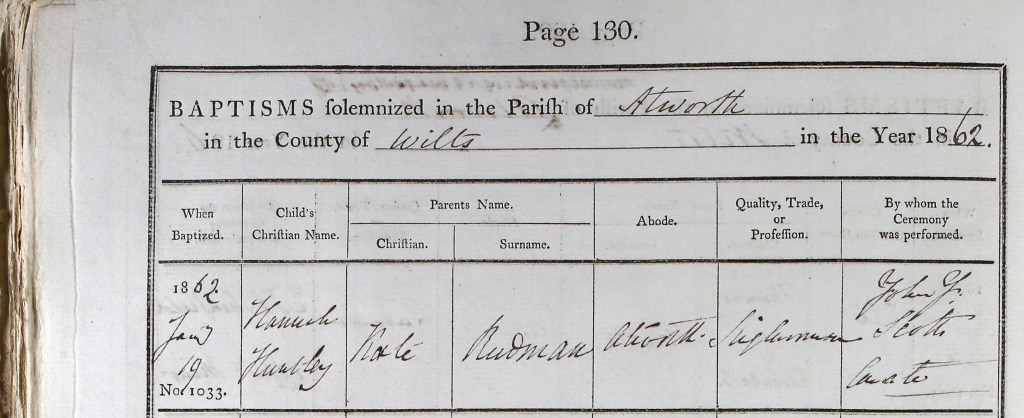
Kate is described as a singlewoman and it is likely that Huntley, the middle name given to the baby, was the name of the father. Looking at census returns in the area, the most likely candidate is John Huntley, a 25 year old unmarried carter, living in Atworth in the 1861 census but further research is needed to see if he was indeed the father. For whatever reason, Kate did not choose to marry the father of her child or perhaps, marriage was not offered. However, she did fall in love with James Bullock. How they met is uncertain. Compton Bassett, the home village of James, is around 15 miles distant from Atworth, Catherine’s home village.
James Bullock had been born in Compton Bassett, Wiltshire, in 1841. As a young man, he had made up his mind that he wanted a different life from his father, Angel Bullock. He was ready to leave home and find adventure, working on the railway rather than on the land. His railway employment records state that he entered service at the age of 22, just before his marriage in 1864. With his new job as a porter at Ealing station, James and his sweetheart, Catherine, probably accompanied by little Hannah, started their married life, away from their rural roots. Ealing, with its easy access into central London, had grown from a small village to a popular suburb following the arrival of the Great Western Railway in the 1830s, which linked Bristol to London.
After their marriage in July 1864, James and Catherine found lodgings in Hanwell, a village ca. 1.5 miles west of the centre of Ealing. One of the best known local landmarks in Hanwell was the Wharncliffe Viaduct, built in 1836 by Isambard Kingdom Brunel so trains could cross the River Brent. It must have been a familiar sight to them:

It wasn’t long before James and Catherine started a family together. They celebrated the birth of a daughter, Eliza Rebecca, in April 1866 and a son, Josiah Simeon Thomas Bullock, my great grandfather, in December 1867. Both were baptised in the parish church of St Mary, Hanwell. Hannah must have been excited to have a sister and brother to play with:
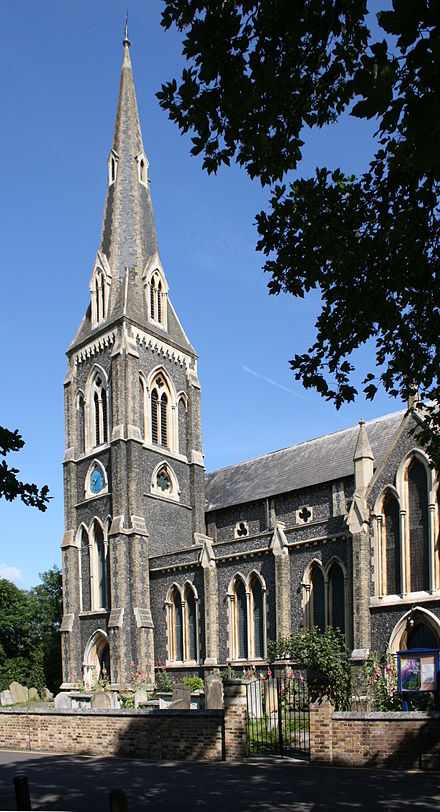
However, the Bullock family didn’t stay in Hanwell for long. According to the employment records kept by the Great Western Railway, James Bullock got a job as a booking porter at the station of Wyre Forest, Worcestershire on June 1st 1869:

Perhaps James and Catherine had got tired of city life and wanted to bring up their young family in the country. The station at Wyre Forest, situated on the Tenbury and Bewdley Railway line, was brand new when James joined, opening in June 1869. It was a single-platform station in the middle of the forest with a small goods siding, close to the village of Far Forest. As a booking porter at this small, remote station, James would have more responsibilities and as a married man, he was entitled to live in a house owned by the railway company. The new posting also meant a salary increase, from 17 shillings to 21 shillings a week. James was to be in charge at Wyre Forest for the rest of his railway career.
This is the station house at Wyre Forest, the home where James and Catherine spent the rest of their married life. Sadly, the railway line is long gone, the station closing to passengers in 1962 and goods in 1965:

In 1870, James and Catherine had a daughter, Miriam, and the following year, the family were recorded in the 1871 census:

James Bullock is described as the station master, even though his official grade and salary was that of a booking porter at the time. However, as it was such a small station, he was the only member of staff there so essentially, he was running it single-handedly. The children were Eliza, aged 4, Josiah, aged 3 and the 9 month old baby, Miriam. However, also with them was 9 year old Hannah Rudman, who was described as a visitor. She was a scholar so was attending school.
The big question here is whether Hannah grew up with the rest of her half siblings at Wyre Forest. The description of “visitor” suggests that she was not a permanent member of the household. Why did James Bullock not describe her as his stepdaughter or even daughter, if he had been so minded? Alternatively, when James Bullock filled in the form, “visitor” might just have seemed the best option to him, given he was not her father. I don’t believe Hannah was brought up by her maternal grandparents, as they were probably deceased by this date, and Atworth in Wiltshire, her place of birth, was rather far away for this to be a quick visit.
Since Hannah was born after the 1861 census and had left home by the time of the 1881 census, this is the only source I have where Hannah is recorded with other family members. When I first viewed this census record, many years ago, I was struggling to find information on Catherine’s origins, so I was pleased to find someone else, obviously a family member on her side, that confirmed her place of birth. With no index or access to the Atworth registers at the time, I did not investigate Hannah any further.
In the future, I hope to be able to confirm that Hannah spent her childhood with the rest of the family by looking at school log books. A school was established in Far Forest in 1829, opposite the vicarage, and with the passing of the Education Act in 1870, it became a Board School. There are school log books from 1866-1900 for Far Forest at the Worcestershire Archives so my goal will be to hopefully find a record of Hannah’s attendance there.
For the next twenty years, I lose sight of Hannah. By the time of the 1881 census, she would have been 18 years old, and was out in the world. In the meantime, the Bullock family had expanded with the birth of Ernest Bruce Wright in 1873, North Rees in 1876 and Ruth Rose in 1878. In all likelihood, Hannah was working in service from her youth. I caught up with her in the 1891 census:

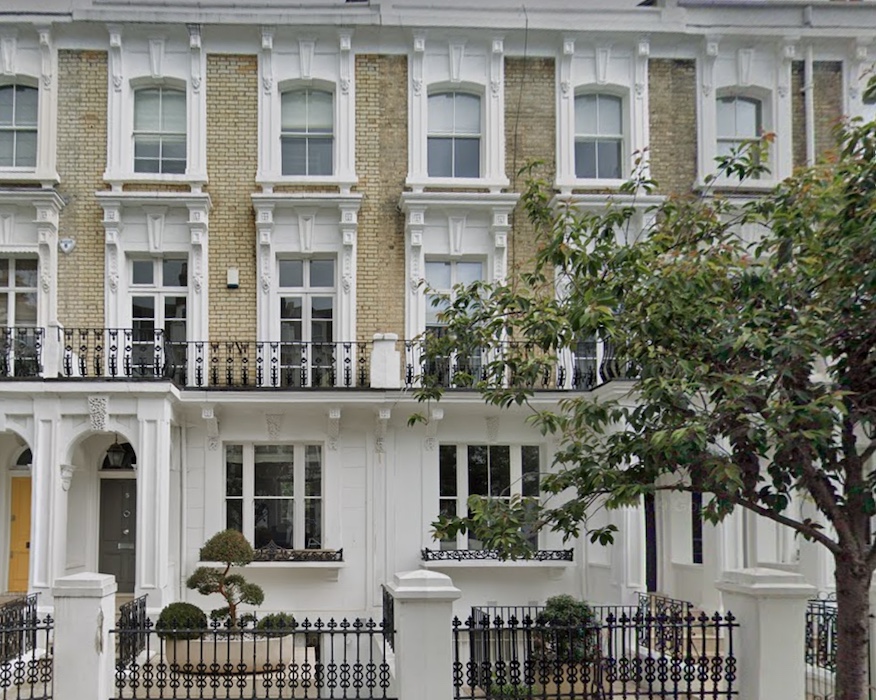
Hannah was 28 years old and working as a domestic servant for the Thomas family. The head of the household was James Thomas, a 70 year old linen draper, who was living with his 70 year old wife, Eliza, and son, G. A. Clay Thomas, who was 39 years old, single and a commercial draper. From subsequent events, it is clear that a romance was developing behind the scenes. This romance led to a proposal and on January 25th 1896, George, Alexander Clay Thomas married Hannah Redman:

Hannah says that her father was Henry Redman, a farmer, who was deceased. This is clearly a fabrication to hide her illegitimate birth. James Thomas, the father of George is also recorded as deceased. In fact, both of George’s parents died towards the end of 1894. Perhaps this cleared the way for George to marry Hannah; his parents may well have objected to their son marrying the house servant. With his father’s death, the family drapery business was probably dissolved, as George was now working as a coal merchant.
No occupation is recorded for Hannah, but she may well have continued working as a servant after the death of her employers. Her residence at the time of her marriage was 98 Finborough Road, close to her fiance who was living at 48 Eardley Crescent:
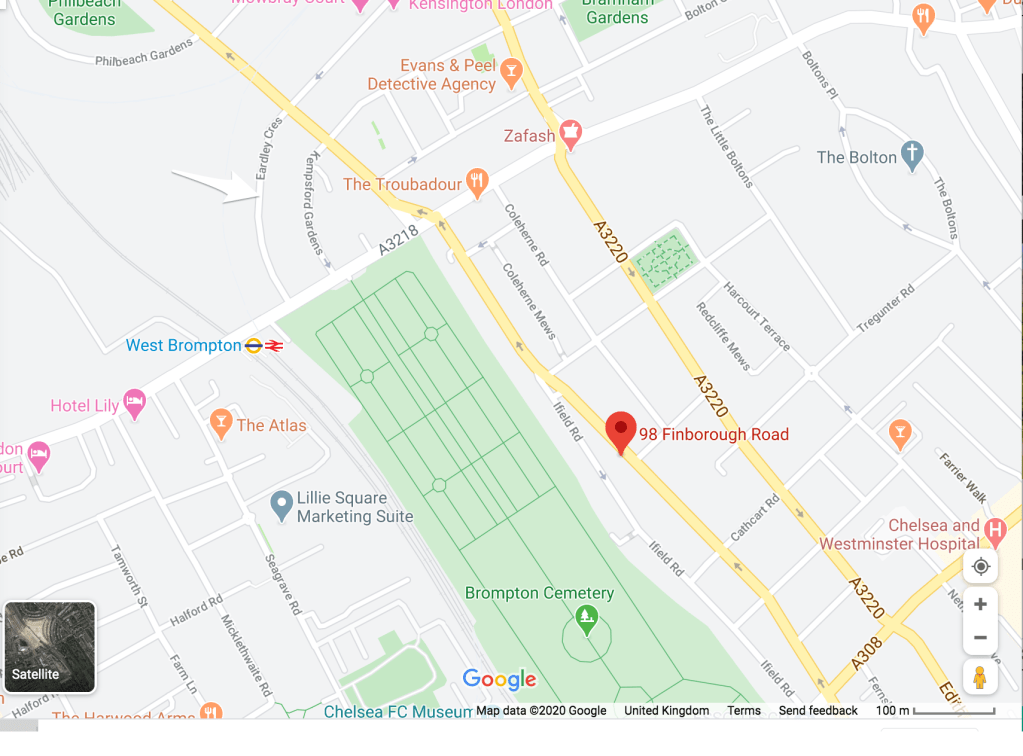
Sadly, the marriage of George and Hannah was to be short-lived. A search of the 1901 census revealed no sign of the couple. Perhaps George had died and Hannah had married again? However, a careful search of the General Register Office (GRO) death indexes revealed the death of a Hannah Thomas, aged 37, registered in Fulham in the March quarter of 1899. I obtained a copy of the death certificate and found that Hannah had indeed tragically died:

Hannah and George had only been married for three years. Although Hannah died in the Union Infirmary, George is recorded as having been in attendance. I like to think that he was devoted to her in her final illness. This is their home address of 99 Dawes Road, Fulham:
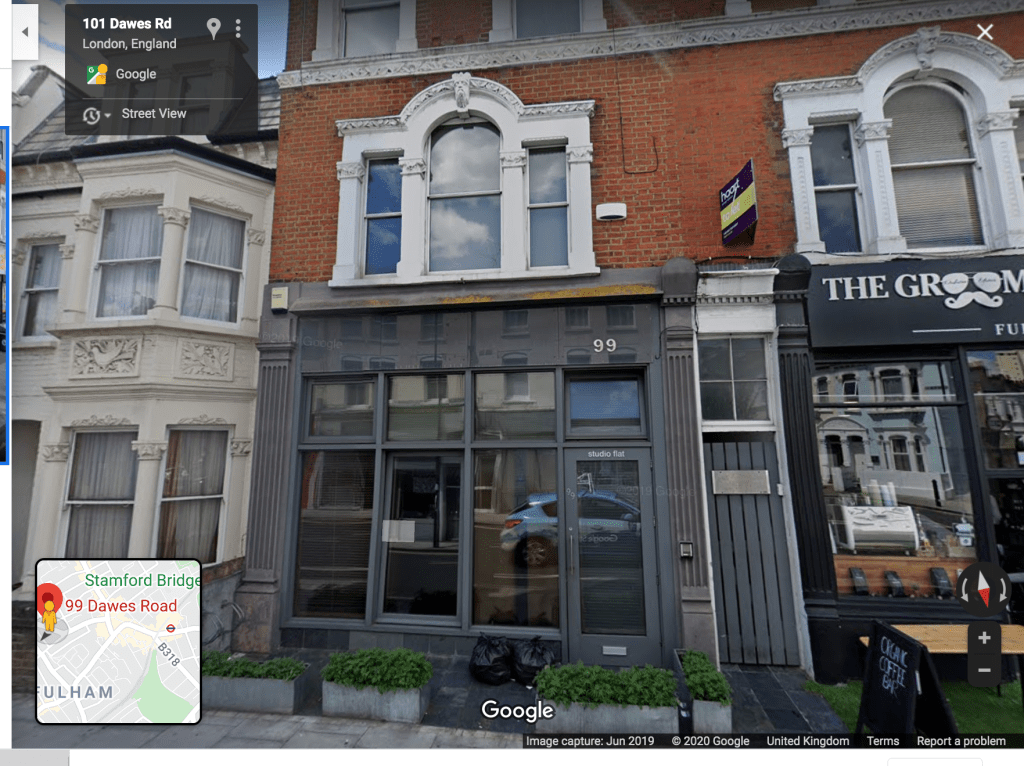
Sadly, George was not to live long after the death of Hannah. I found a reference to his death in the GRO indexes, registered in the September quarter of 1899 in Fulham. He was aged only 48.
George had been working as a coal agent and after the death of his father and the loss of his position in the family firm, his financial resources may have dwindled. Perhaps he was unable to work for a time if he was ill. He did not leave a will and I am not aware that he and Hannah had any children. In 1915, an administration was produced for his estate, this amounting to only £137, his nephew, Arthur William Clay Thomas, a vocalist, being the administrator. The address of the family home, 5 Redcliffe Street is given in the abstract:

There are still many questions about the life of Hannah Redman. Did James Bullock really welcome Hannah when he married her mother, Catherine? Did Hannah move to Hanwell from Atworth, Wiltshire, as a small child and attend her mother’s wedding? I cannot be certain, but she could well have been there. When writing about her life, I have tried to picture the scene and excitement of the big day. If James Bullock was lodging at The North Star public house with the Theobalds, who witnessed the marriage, it is plausible that Catherine and her daughter stayed there too on the night before the wedding. Hopefully, Hannah was able to enjoy a happy childhood surrounded by all her brothers and sisters. The school log books at Far Forest may provide an answer here. As I have been unable to find Hannah in the 1881 census, little is known about her early life. However, she does appear to have found love with a husband and home of her own upon her marriage to George Alexander Clay Thomas in 1896. Given the difference in their social status, they must have cared for each other deeply to take this step against the conventions of society. It was probably not a match welcomed by the rest of his family. I’m sad that they had so little time together.
Postscript
In the Victorian period, it was not uncommon for women to become pregnant before marriage. In many instances, this resulted in a hasty wedding but inevitably, some women were left to bring up a baby on their own and had to deal with social stigma and the financial repercussions. It could be very difficult to get a father to acknowledge his child, let alone ensure that they provided support. Not all women had recourse to family help. Sometimes, a mother’s subsequent marriage and a generous stepfather meant that the child was absorbed into a new family. I hope this was the case with Hannah Redman.
As I have mentioned, the only record I have of Hannah Redman living with other family members is the 1871 census, when she was described as a visitor. It was only through the indexing of the Atworth baptismal registers that I discovered her baptism and her true identity was revealed. Without a record of her baptism, her life may well have remained undiscovered and her story unknown. The value of looking at parish registers over a wide period of time is clear: you may find some surprising entries. Some babies born illegitimately may only be recorded in parish registers because they died in infancy. Others, particularly when were brought up away from their birth mother in another family, are undetected and unknown. They need to be found.
@ Judith Batchelor 2020
Stunning depth of research and how wonderful that you pursued it for Hannah. You’re writing is easy to digest and makes me want to go out hunting for more family stories myself.
LikeLiked by 1 person
Thank you, happy to inspire you! 😀
LikeLike
A beautifully written and well-reasoned family history for Hannah. She will be remembered thanks to your research and biography.
LikeLiked by 1 person
Many thanks! It is particularly nice to commemorate a female ancestor too, as they often get overlooked.
LikeLiked by 2 people
Hello Judith Another intriguing story! Thank you for the way you creatively imagine what the backstory is for Hannah. Interestingly Nana was in service in 1911, in the parallel street at 35 Redcliffe Road! The houses look very similar too. Marcus and I went to find it when he was living in Kensington a few years ago. Hope that you are all well? I have had very little time for genealogy recently as our restore is moving on the Seaford in September and as churchwarden I am now in a position of considerable responsibility! I am glad I had a break during lockdown and am up for the new challenge. I just hope and pray that the vacancy doesnt drag on fr too long Heather x
Sent from my iPad
>
LikeLiked by 1 person
Interesting, I hadn’t made that connection with Redcliffe Street before. It does look a very smart road.
Wishing you well with all your churchwarden responsibilities!
LikeLike
A beautifully told tale Jude, full of excellent research, but like family stories, it throws up just as many questions as it does answers. Would a DNA test help solve the unknown Father, given you have a possible candidate?
LikeLiked by 2 people
Unfortunately, I don’t think Hannah had any children so it won’t be possible to identify her father through DNA. There may be some court or parish records available that could reveal if he was indeed John Huntley of Atworth.
LikeLiked by 2 people
Also worth checking the newspapers as well, you never know!
LikeLiked by 1 person
Hi. Nephews, nieces, or their descendants might also help, if anyone has (or would) do a DNA test…
LikeLiked by 1 person
Sadly, DNA from the descendants of nephews and nieces won’t help to unlock the paternity of Hannah, as they had a different father. Hopefully, there will be records that will point to the identity of Hannah’s father.
LikeLike
I might have found her in 1881?
Have sent you an email message and link.
LikeLiked by 1 person
Brilliant! That’s very kind of you to search for Hannah in the 1881 census. I think it is definitely a promising entry but it is difficult to know conclusively. Age and location match perfectly, place of birth is close. On the balance of probability I think it is her.
LikeLike
I love the way you have imagined the wedding from young Hannah’s point of view. It’s really romantic that she married her employer’s son, and very sad that they only had a few years together. Do you know what his cause of death was? It came so soon after Hannah’s.
LikeLiked by 2 people
Thank you! I thought it would be more interesting to take the story from the wedding, with Hannah being present there, rather than the more usual chronological approach.
I think it was pretty uncommon for an employer to marry a servant. Affairs happened sometimes I’m sure but they did not usually lead to marriage. I haven’t ordered the death certificate of George A. C. Thomas so I don’t know his cause of death. I’m really tempted though so mayit.
LikeLike
You tell Hannah Redman’s story well. It is difficult when there are no paternity clues, and makes it impossible to trace back further with clarity. The 1864 birth certificate of my mother’s father’s mother only has the girl child and her single mother’s names. By the time of the 1871 census they were living as a family with a widower and his daughter b. 1862 – listed as a married couple with two daughters all using his surname. Both daughters later married with certificates which named him as their father. His wife died in January 1865, six months after my great grandmother was born. No later marriage certificate. If they all knew what had happened and spoke about it in the family what happened was not passed on to later generations.
LikeLiked by 1 person
There is often some secrecy concerning children who are born illegitimately. It may be possible to establish if this man was indeed the father of your ancestor through DNA testing.
LikeLike
Yes in this case that would mean identifying other descendants of his parental family because the daughter from his marriage had no children – her husband died the year after they married.
LikeLiked by 1 person
This is a fascinating and well written story. I was gobsmacked to see the reference to Dawes Road in Fulham, as that was where I lived for the first 22 years of my life (at number 36, though, not 99 … that’s actually why my username is Sue036)!
LikeLiked by 1 person
It’s funny when you find these unexpected coincidences and connections! 😁
LikeLike
Last year, a silver cup won by a great grandfather of mine, was returned to our family. I had already seen that his father was the minister of Christchurch Ealing, but only recently (thanks to an Ealing guided walk description) had identified this church as the current Christ the Saviour. Nice to see the signature of the Rev Joseph Stephen Hilliard on the marriage certificate of James and Catherine. I wonder why the church is described as the District Church if I read it correctly. This great grandfather, Francis Porteus Tyrrell Hilliard, I have discovered (unknown to my own mother) is buried on the island of Madeira. At that time the climate was considered helpful for TB sufferers and other invalids. The archivist at the English Church is seeking his death certificate in their archives to confirm or deny this theory.
LikeLiked by 1 person
Hi Graham, interesting to hear of your family connection to the church that features in my story. It is always great to see the signature of an ancestor. Clergymen had to sign their names a lot!
I think a district church was so called because there was more than one church in the parish. In urban areas, additional churches were sometimes built to serve the growing population. The “mother” church was the original parish church.
I think your theory that your great grandfather went to recuperate on Madeira sounds very plausible. Certainly, fresh air and a warmer climate was thought to be beneficial for health. It will be exciting to see his death certificate.
LikeLiked by 1 person
Poor Hannah, to die so young after seemingly having found a happy marriage. When looking at census records I tend to dig down into the identities of “visitors” and “boarders” to determine if there was actually a relationship to the rest of the family.
In 1841, my 3x great-grandmother, Sarah White was recorded with her parents, along with her 6 year old daughter, Eliza…Of course, her married name was written in and in the “Profession” column, visitor was inserted. Now, because I know her married name and that she did indeed at that point have a 6 year old daughter Eliza, and that her husband was recorded at home with their boys, I knew the relationship she had to the HoH. Someone new to researching the White family might not and gloss past Sarah and Eliza.
LikeLiked by 1 person
Yes, it’s surprising how often there is a family relationship hidden in the term “visitor”. If the child born illegitimately took the name of their stepfather, the date of the mother’s marriage may consequently be later than one would expect.
LikeLike